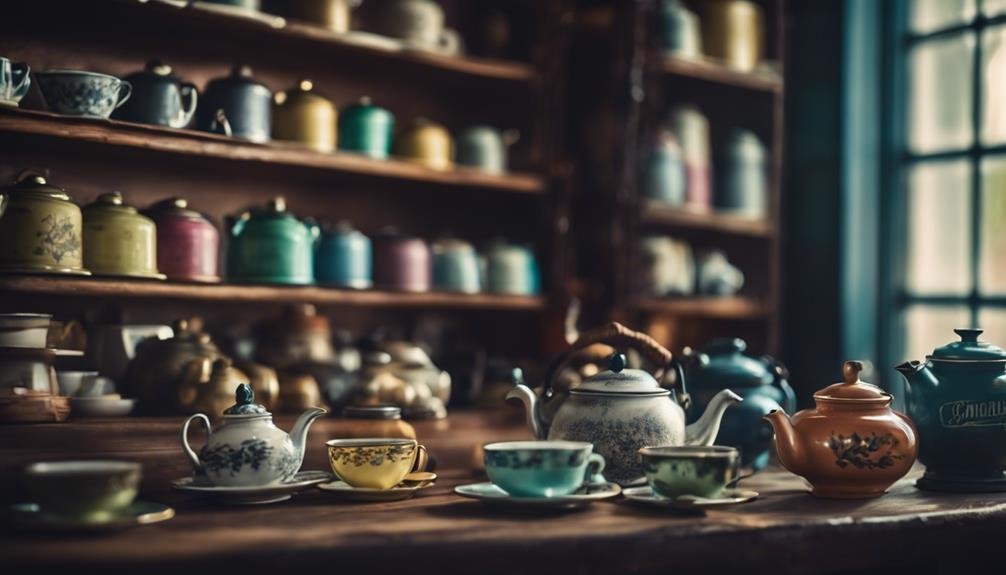The Entrepreneur's Guide to Starting a Specialty Tea Shop
They say, 'A watched pot never boils.'
Starting a specialty tea shop requires patience and strategic planning to brew success.
Imagine the satisfaction of curating a unique tea selection that captivates your customers' taste buds and leaves them craving more.
As an entrepreneur venturing into the world of tea, there are crucial steps you must take to infuse your vision into a thriving business.
From defining your target market to creating a cozy atmosphere that invites tea enthusiasts, every aspect plays a vital role in setting your specialty tea shop apart.
Key Takeaways
- Conduct thorough market research to understand consumer preferences and market trends.
- Develop unique and innovative tea blends to differentiate your shop.
- Establish ethical supplier relations for premium and diverse tea sourcing.
- Focus on creating a welcoming atmosphere and enhancing customer experience for success.
Finding Your Niche in Tea
Wondering how to carve out your unique space in the vast world of tea specialties? With the ever-evolving tea trends and diverse consumer preferences, finding your niche in the tea market is crucial for the success of your specialty tea shop. One effective strategy is to tap into niche markets within the tea industry. By identifying specific segments of tea enthusiasts, such as health-conscious consumers, eco-friendly advocates, or adventurous tea connoisseurs, you can tailor your offerings to cater to their unique preferences and needs.
To stay ahead of the curve, keep a close eye on emerging tea trends that present opportunities for differentiation. Whether it's introducing innovative tea blends, sourcing rare teas from specific regions, or incorporating tea-infused products, staying informed about the latest developments in the tea industry can set your specialty tea shop apart from the competition. Embracing niche markets and aligning your offerings with current tea trends won't only attract a loyal customer base but also establish your shop as a go-to destination for tea enthusiasts seeking distinctive and high-quality teas.
Conducting Market Research
To establish a successful specialty tea shop, conducting thorough market research is essential. Utilizing tools such as online surveys and focus groups can provide valuable insights into consumer preferences, trends, and potential demand for your tea shop. Online surveys allow you to gather data from a large pool of respondents quickly and efficiently. By crafting targeted questions, you can uncover valuable information about the types of teas customers are interested in, their purchasing habits, and what factors influence their decision-making process.
In addition to online surveys, organizing focus groups can offer a deeper understanding of your target market. By bringing together a small group of individuals to engage in discussions about tea preferences, pricing expectations, and overall shopping experiences, you can gain qualitative insights that may not be captured through surveys alone. Focus groups provide a platform for open dialogue and real-time feedback, allowing you to refine your business strategy and tailor your offerings to meet the needs of your customers effectively.
Conducting comprehensive market research through online surveys and focus groups will equip you with the necessary information to make informed decisions and set your specialty tea shop up for success.
Crafting Your Tea Menu
When crafting your tea menu, consider factors like:
- Tea Selection Criteria
- Flavor Pairing Suggestions
- Seasonal Menu Rotations
These aspects are crucial in creating a well-rounded and appealing menu that caters to a variety of tastes and preferences. By focusing on these points, you can ensure that your specialty tea shop offers a diverse and enticing selection for your customers.
Tea Selection Criteria
Crafting a well-curated tea menu for your specialty tea shop involves carefully selecting teas that cater to the diverse preferences of your customers. When considering your tea selection criteria, keep in mind the following key points:
- Tea Tasting Events: Conduct regular tea tasting events to introduce new flavors and gather feedback directly from your customers.
- Customer Preferences Survey: Create a survey to understand your customers' favorite tea types, strengths, and flavors.
- Seasonal Offerings: Rotate your tea selection based on seasonal preferences to keep your menu fresh and exciting.
- Specialty Blends: Consider offering unique and exclusive tea blends to differentiate your shop and attract tea enthusiasts.
Flavor Pairing Suggestions
As you curate your tea menu with a focus on flavor pairings, consider blending teas that complement each other harmoniously, enhancing the overall taste experience for your customers. Tea blending allows you to create unique flavor profiles that can tantalize the taste buds of your patrons. To ensure a well-rounded menu, think about the different types of tea and how they can be combined to offer a diverse selection for tea tasting. Experiment with various combinations to find the perfect balance of flavors that will set your specialty tea shop apart. Here is a simple guide to get you started on your tea blending journey:
| Base Tea | Complementary Flavor |
|---|---|
| Green Tea | Jasmine |
| Black Tea | Bergamot |
| Rooibos | Vanilla |
Seasonal Menu Rotations
To ensure a dynamic and engaging experience for your customers, consider implementing seasonal menu rotations in crafting your tea menu. By adapting to seasonal trends and focusing on unique tea sourcing, you can elevate your shop's offerings and keep customers intrigued. Here's how you can effectively execute seasonal menu rotations:
- Stay Updated: Regularly research and source teas that align with current seasonal trends.
- Experiment Creatively: Play with different flavor profiles and ingredients to create seasonal tea specials.
- Engage Customers: Encourage customer feedback and suggestions for seasonal tea blends.
- Training Staff: Educate your team on the nuances of the seasonal teas to provide excellent recommendations.
Securing Suppliers and Partnerships
When starting your specialty tea shop, securing reliable suppliers and forming strong partnerships will be crucial to sourcing high-quality teas for your menu.
It's essential to establish relationships with reputable tea suppliers who can provide a diverse range of premium teas to meet the preferences of your customers.
Quality Tea Sources
Securing quality tea sources for your specialty tea shop involves establishing strong partnerships with reputable suppliers. To ensure you have access to the best teas for your customers, consider the following key points:
- Tea farm visits: Take the opportunity to visit tea farms directly to understand the sourcing process and quality control measures.
- Direct trade sourcing: By engaging in direct trade with tea producers, you can ensure transparency and build long-lasting relationships.
- Organic certification: Look for suppliers that offer organic-certified teas to meet the growing demand for organic products.
- Fair trade options: Consider partnering with suppliers that support fair trade practices to promote ethical sourcing and sustainability in the tea industry.
Establishing Strong Partnerships
Establishing strong partnerships with reliable suppliers is crucial for the success of your specialty tea shop. Partnership dynamics are key, so focus on clear communication to ensure both parties are aligned.
Building trust with your suppliers is fundamental; choose partners who share your values and commitment to quality. Collaboration is essential for a mutually beneficial relationship – work together to innovate and grow your businesses.
Regularly communicate your needs and expectations, while also being open to feedback and suggestions. By fostering strong partnerships based on trust and effective communication, you can secure a steady supply of high-quality teas for your shop.
Designing Your Tea Shop Layout
Consider incorporating cozy seating areas and a designated tea bar when designing your tea shop layout. These elements can create a welcoming and relaxing atmosphere for your customers. Here are some key aspects to keep in mind:
- Seating Arrangements: Arrange your seating to cater to different group sizes, from cozy two-seaters to larger tables for groups. Comfortable seating is essential for customers to enjoy their tea experience.
- Lighting Choices: Opt for a mix of natural light and warm artificial lighting to create a cozy ambiance. Soft lighting can enhance the overall mood and aesthetics of your tea shop.
- Display Setup: Strategically place your tea displays to entice customers with visually appealing presentations. Showcase your tea varieties and accessories in an organized and eye-catching manner.
- Counter Design: Design a functional and aesthetically pleasing tea bar where customers can interact with your staff and witness the tea-making process. A well-designed counter can enhance customer engagement and satisfaction.
Obtaining Permits and Licenses
Obtain the necessary permits and licenses to legally operate your specialty tea shop, ensuring compliance with local regulations and requirements. Start by researching the permit process and regulations specific to your location. Contact your local government offices or visit their websites to understand the necessary steps and documentation needed to apply for permits. Be prepared to provide details about your business, such as the location of your tea shop, its size, and the nature of your operations.
Next, familiarize yourself with the license applications and fees required to run a tea shop. Determine the types of licenses you need, such as a business license, health department permit, or food service license. Check the application deadlines and ensure you have all the necessary paperwork ready for submission. Budget for the associated fees, which may vary depending on the type of license and your location.
Developing Your Brand Identity
To solidify your specialty tea shop's presence in the market, crafting a distinctive brand identity is crucial for attracting and retaining customers. Developing a strong brand identity involves more than just a logo; it encompasses the essence of your business and what sets it apart from competitors.
Here's how you can create a compelling brand identity for your specialty tea shop:
- Brand Messaging: Clearly define your brand's values, mission, and unique selling propositions. Your brand message should resonate with your target audience and communicate what makes your tea shop special.
- Visual Identity: Design a visually appealing and cohesive brand identity that includes your logo, color scheme, typography, and overall aesthetic. Consistency in visual elements across your store, packaging, and marketing materials helps in building brand recognition.
- Customer Experience: Create a consistent and memorable experience for your customers that aligns with your brand identity. From the ambiance of your store to the interactions with your staff, every touchpoint should reflect your brand values.
- Brand Personality: Infuse your brand with a distinct personality that connects with your customers on an emotional level. Whether it's through storytelling, social media engagement, or community involvement, let your brand personality shine through in all interactions.
Marketing and Promotions Strategy
Crafting an effective marketing and promotions strategy is essential for maximizing the visibility and appeal of your specialty tea shop to potential customers. To create a buzz around your business, consider leveraging social media campaigns and influencer collaborations. Utilize platforms like Instagram, Facebook, and Twitter to showcase your unique tea offerings, engage with your audience, and attract new customers. Collaborating with influencers who align with your brand values can help increase brand awareness and credibility.
In addition to online strategies, offline efforts are equally important. Hosting community events such as tea tasting sessions or workshops can draw in local customers and create a sense of community around your tea shop. Partnering with local businesses or organizations for cross-promotions can also help expand your reach and attract new clientele.
Providing Exceptional Customer Experience
Enhancing the customer experience at your specialty tea shop involves creating a welcoming atmosphere that entices visitors to linger and explore your tea offerings. To ensure exceptional customer experience, consider the following strategies:
- Tea Tasting Events: Host regular tea tasting events where customers can sample a variety of teas and learn about their unique flavors and benefits.
- Interactive Tea Workshops: Offer interactive workshops where customers can engage in the art of tea-making, learn brewing techniques, and discover the rich history of different tea varieties.
- Customer Loyalty Programs: Implement loyalty programs to reward frequent visitors with discounts, special offers, or exclusive access to new tea blends or events.
- Personalized Tea Blends: Provide a personalized touch by offering custom tea blending services, allowing customers to create their unique tea blends tailored to their preferences.
Conclusion
As you embark on your journey to open a specialty tea shop, remember this: The specialty tea market is booming, with the global market expected to reach $56 billion by 2024.
By following the steps outlined in this guide, you're well on your way to success in the tea industry. Stay focused on your niche, provide exceptional customer experiences, and watch your tea shop thrive in this growing market.
Good luck on your entrepreneurial adventure!







